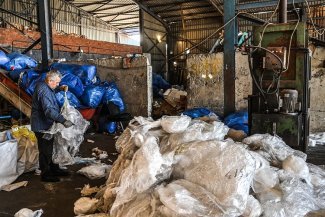
Seventy per cent of the African population depends on agriculture to make a living. The sector also generates between 25 and 35 per cent of all direct jobs on the continent.
It is midday at Kiliku village in Machakos County, about 90 kilometres east of the Kenyan capital of Nairobi, and Nicholas Mutiso is sitting on a rock with a pen and a notebook, listening keenly to the words of local agricultural extension officer, Robert Kioko.
Thirty-year-old Mutiso is a farmer and one of over 300 men and women attending a series of trainings organised by the Machakos County local government in partnership with Greenpeace Africa and the Institute for Culture and Ecology (ICE), a Kenyan NGO focused on environmental and resource management.
Participants are being taught about climate-smart agriculture (CSA), farming methods that will enable them to make the most of their own land by helping to ensure food security and economic empowerment from the sale of surplus crops such as sorghum, millet, green grams (mung beans), cassava and cow peas.
“Apart from the good farming practices we are taught, we are also encouraged to plant trees in order to reclaim our area as we are sitting on the foot of Ol Donyo Sabuk (Kilimambogo) mountain which was once a forest full of wild animals. But since it was cleared for charcoal, now we have limited rain,” Mutiso explains.
Kioko teaches the farmers about the use of zai pits, a CSA farming method that originates from the Sahel region of west Africa and helps with rainwater management as well as the protection of soil conditions.
Farmers are required to dig two-foot pits (although the dimensions can vary) to plant their crops in. The first foot of soil is removed and mixed with organic manure that the farmers prepare themselves. The second foot of soil is also removed and put aside, leaving a depression to conserve water. Nine crops (seeds or seedlings) are then planted in each pit.
Janet Ndunge is a farmer in Kiliku village. She has been part of the training programme since it began in 2013. The 50-year-old mother of four says that climate-smart farming has transformed the fortunes of her family.
“I and my husband now depend fully on farming to put food on the table and educate our children,” she says. The couple have three acres of farming land, one acre of which is under zai pits. Ndunge says that 90 zai pits produce a single, 90 kilogram sack of maize which is enough for them to eat and sell the surplus for money.
Agricultural transformation
But zai pits are just one example of the kind of CSA initiatives that can help to “guide [the] actions needed to transform and reorient agricultural systems to effectively support development and ensure food security in a changing climate,” according to the Food and Agriculture Organization.
Other examples in Kiliku village include teaching farmers to practice soil conservation by building gabions and terraces on their sloped lands to prevent the soil from being swept away during heavy downpours.
“Apart from the training and capacity building, we also give the farmers material support such as the supply of seeds. And we insist on the use of organic manure, that they prepare themselves in their farms,” Elijah Kamau, the programme officer in charge of livelihoods at ICE, tells Equal Times.
Across Kenya, the government is rolling out a number of CSA initiatives. In 2015, Kenya launched its National Policy on Climate Finance, which seeks to position Kenya to better access climate finance (money earmarked for climate change mitigation/adaptation activities) through a variety of mechanisms. Also in 2015, the International Centre for Tropical Agriculture (CIAT) with support from the World Bank, developed a CSA Country Profile for Kenya, to assess, monitor and support CSA projects across the country.
In addition, earlier this year the US$280 million, World Bank-backed Kenya Climate-Smart Agriculture Project was launched. According to the project brief it aims to increase “agricultural productivity and build resilience to climate change risks in the targeted smallholder farming and pastoral communities in Kenya, and in the event of an Eligible Crisis or Emergency, to provide immediate and effective response.”
Kenya, like the many other countries in the Horn of Africa region, has battled with food insecurity in recent years. This February, President Uhuru Kenyatta declared the drought affecting 23 out of the country’s 47 counties a national disaster.
In March, the United Nations Office for the Coordination of Humanitarian Affairs (OCHA) led an appeal for US$165.7 million to provide 2.6 million people in Kenya with life-saving assistance. As only 43 per cent of the funding target has been met to date, in September the target was revised to US$106 million. Meanwhile, according to an UNOCHA report, 3.4 million people in Kenya are facing food insecurity, 2.6 million severely, 800,000 of which are expected to reach crisis levels this month.
Can climate-smart agriculture help prevent such disasters in the future? Not on its own, according to one expert.
“Climate-smart agriculture cannot be the only solution to food insecurity as it requires a number of interventions, but it is key and could have solutions, especially to mass starvation in Kenya,” says Peter Odhengo, a senior policy advisor on climate finance at the National Treasury. He says that “smallholder farmers need to be supplied with seeds which are resilient to prolonged droughts and water conservation techniques should also be put in place.”
Food security
Agriculture is one of Africa’s most vital sectors. It is currently worth about US$300 billion but according to some estimates it could grow to US$1 trillion by 2030 as 60 per cent of the planet’s unexploited arable land is thought to be on the continent. Some 70 per cent of the African population depends on agriculture to make a living and it generates between 25 and 35 per cent of all direct jobs.
However, the sector is highly vulnerable to the extreme effects of climate change. Despite emitting less than 4 per cent of the world’s total greenhouse gas emissions, Africa is home to seven of the ten countries most affected by climate change according to the Climate Change Vulnerability Index 2015.
In early September, African agriculture and climate change took centre stage during the 7th African Green Revolution Forum, organised by the African Development Bank (AfDB) in Abidjan, Côte d’Ivoire.
Experts and policy makers met in a symposium titled “The business of smallholder farmers: building resilience and mitigating and adapting to climate change in African agriculture” where Anthony Nyong, director of climate change and green growth at the Bank, called on governments and the private sector to invest more in the kind of development projects that will help smallholder farmers overcome the challenge of climate change. Failure to do so, he argues, will see Africa fail to meet its food security targets.
“African farmers have demonstrated a limited capacity to adapt to modern information-gathering tools on climate change. They cannot overcome a challenge they do not understand, and that is why more governments need to increase their expenditure on developing meteorological stations required to deliver necessary information to the farmers,” Nyong told attendees.
Greenpeace Africa launched the Food For Life campaign in 2014 where they documented evidence from across the region and found that ecological farmers are getting better yields and are making much more money (approximately US$540 per acre for agro-ecological farmers as opposed to US$200 per acre for conventional farmers). “It’s not a question of just food security. It’s also about farmer livelihoods, and both of these issues are largely addressed by agro-ecological farming,” says Siddharth Sreenivas of the Food for Life campaign.
“We will further engage and collect data to find out what farmers learn from these workshops and see how they have improved their lives,” says the Johannesburg-based campaigner.









